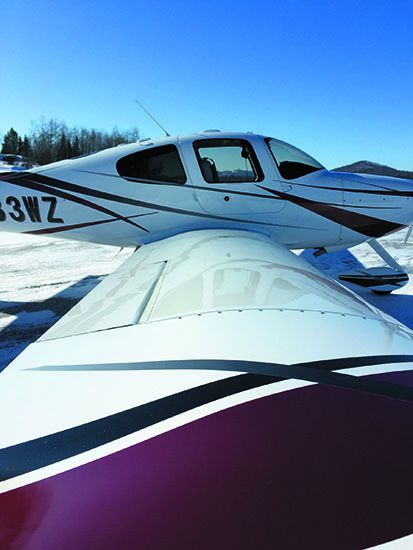In the spring of 2015, contributor Ken Newman installed an Air Graphics custom vinyl appearance kit on his second-gen Cirrus for a field report in the May 2015 Aviation Consumer. While we liked the quality of the kit, we didn’t know how the kit would hold up over time. While less expensive and easier than a new custom paint job, the real test would be to see how the vinyl graphics would age over time. Would it fade, chip, crack or come off? What would it take to maintain? Here’s an update.
THE PROCESS – NOT FOR ALL
After seeing some cutting-edge graphics and paint work on the Generation 5 Cirrus models, Newman recognized that reworking the scheme on his SR22 would be a radical change in appearance from the plain-vanilla design that came from the factory in 2005.
Moreover, vinyl graphics work better on smooth, fiberglass finishes. That makes sense, given the added complexity and challenges that surface rivets and screw heads create during the application process.
After some intensive shopping, he pulled the trigger on an owner-assisted (with his A&P Jim Markey) vinyl graphics project. The vinyl kit came from Air Graphics in Fitchburg, Wisconsin—a firm that has extensive experience designing and executing schemes for Cirrus models on the OEM and aftermarket levels. Air Graphics isn’t the only source for vinyl graphics, but it does offer one of the most comprehensive design services and is we’ll regarded by many paint shops we talked with.
While the price of the project was far less than a custom paint job, it wasn’t trivial at a total buy-in of $6000. This included $1500 of shop labor (owner-assisted, remember) and a total downtime of three days. Worth mentioning is the FAA does not restrict who can do this project. You do not need a paint shop, there is no required signoff and you won’t need to recalculate the aircraft weight and balance. But this isn’t a slap-and-go job, and Newman advises to assess your skills before venturing on the project on your own. If you aren’t careful, you can damage an otherwise good paint job.
If you have a Cirrus and want to refresh the exact original scheme, Air Graphics (or anyone else for that matter) can’t do that. Duplicating any original design must come directly from Cirrus because of copyright restrictions.
The most labor-intensive portion of the project is removing the factory graphics. For this project, a Crud Thug wheel is attached to a Snap-On Tools accessory mount on an air gun. The device is much like a wire wheel and if used incorrectly, can remove paint from the airframe. Once the old graphics are removed, you’ll need to use a glue solvent to remove any glue residue that remains on the surface.
The base paint on this aircraft was in excellent condition, and the process includes polishing the base paint. It is critical to remove oxidation and any ghosts left from the original decals. If the paint is in questionable condition, you should reconsider the project.
It is acceptable to apply the vinyl to control surfaces. However, only a few grams of weight are acceptable to add, plus movement and travel must not be affected. This is where the oversight of an A&P is invaluable, in our view.
Application of the new design starts with a dry masking tape application to check for actual fit. The vinyl is applied with a solution of water with 5 percent soap and 5 percent alcohol. This process requires extra hands and good coordination. As long as the vinyl is wet, it’s workable, but when it dries it becomes fixed, and there it stays. Yes, there is a learning curve. Once the vinyl has set for 24 hours, it’s time to spiff it up with microfiber cleaning and waxing.
HOW’S IT HOLDING UP?
Newman’s Cirrus is always hangared, which obviously makes a huge difference in preserving any paint scheme—paint, vinyl or a combination of the two. Like paint, vinyl will fade from UV exposure, plus dust, dirt and pollution take a toll. Longevity also depends on the kind of weather you fly through.
Newman’s Cirrus has flown roughly 500 hours with the vinyl installed. It generally flies in a combination of VMC and light IMC, with no heavy icing or precipitation. “The care I use is to keep clear leading-edge protecting strips on the leading edges. The aircraft is cleaned with microfiber cloths and a two-step cleaning wax,” Newman reports.
He notes, however—and this may be important—that he mainly stays clear of the vinyl surfaces with strong cleaners and polish. The vinyl simply gets wiped with a microfiber cloth. There has been no fading, but there are some small nicks and chips that can be touched up with a matching paint color or Krazy Glue.
“If the aircraft got heavily used, I think traditional paint would hold up better. But for how I use it, the vinyl wrap has held up beautifully and was a fraction of the cost of a custom paint job,” Newman told us.
We’ll look at some more vinyl wrap options in a full report in an upcoming issue of Aviation Consumer.


